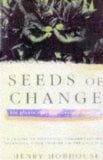 Seeds of Change: Five Plants That Transformed Mankind
Seeds of Change: Five Plants That Transformed Mankind
by Henry Hobhouse
Papermac, £12, ISBN 0333736281
Not a new book, having been first published in 1985 before reappearing in paperback with an increase from five plants to six. Perhaps the world changed a little more in the intervening years. So what is it about quinine, sugar, tea, cotton, the potato and coca, that is so world-changing?
I expected a popular botanical science book with perhaps a bit of geography and economics thrown in for good measure. In fact it’s a quite remarkable work with perhaps the strongest emphasis being on the broader sociological impact of these plants from their earliest discovery to modern times. The linking factor in nearly all cases is slavery, serfdom or its equivalent in this country at the time of the Industrial Revolution, which the author assesses as worse.
The links with outright slavery are perhaps most obvious for sugar and cotton but there are some strange mixtures of good and evil, for example in the use of coca leaves among Peruvian silver miners working at 14,000 feet in the Andes in the 17th Century. A handout of leaves every 45 minutes by the mine owners kept altitude sickness at bay and provided a boost of energy which meant the miners needed about 25 percent less food, a considerable cost saving. And of course it kept them content. Good or evil?
Hobhouse manages to quantify economic parameters which one doesn’t normally consider; the number of slave lives per ton of silver produced for example. But it’s not just a depressing book about human oppression. The economic achievements of the early trade, particularly in sugar, tea and cotton come through vividly, not to mention the human benefits flowing from the use of quinine. But even in the early days of quinine the exploiters and charlatans were active with adulteration and selling “the wrong kind of quinine”. And of course “the church” had its finger in the control and exploitation of most of these plants.





